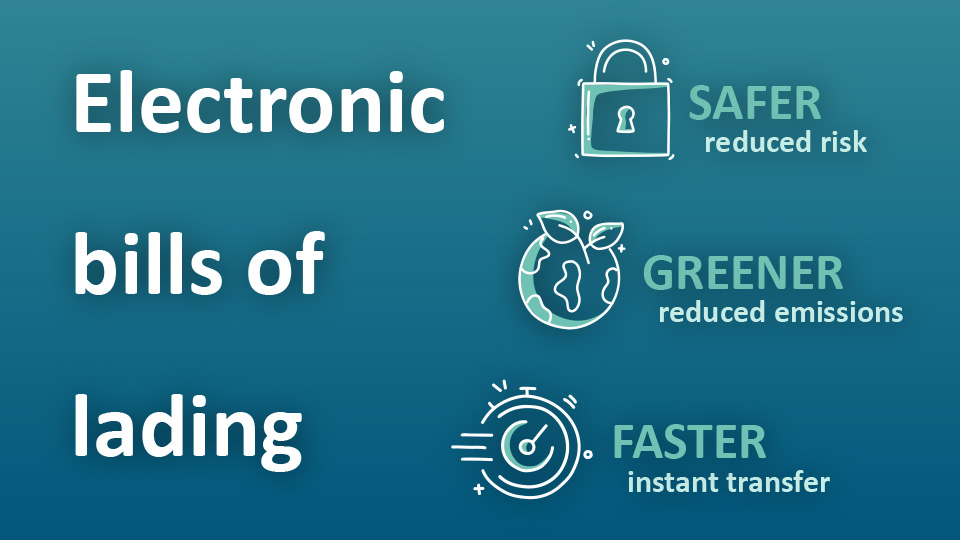
CONTACT BIMCO
Mads Wacher Kjaergaard
Manager, Standards, Innovation and Research
Copenhagen, Denmark
- +45 4436 6833
- mwk@bimco.org

Global trade still relies heavily on paper. The main risks of relying on paper are exposure to fraud, clerical errors and lengthy transfer and processing time. This is despite the fact that issuance of electronic bills of lading (eBLs) has been possible for more than 20 years on safe and well-established platforms approved by the International Group of P&I Clubs.
It is also despite the fact that eBLs are safer, faster, and greener when compared to their paper bills of lading ancestor.
One of the big risks that parties unnecessarily take is when ships turn up at the port of discharge before the paper bill of lading has completed its travel through the trading and banking system. To ensure operations run smoothly, and to avoid delays in discharging cargoes, the bulk shipping trade has over time adopted a commercially feasible, but unfortunate, practice where ships discharge without production of the original paper bill of lading. Instead, they use a letter of indemnity. eBLs, however, could eradicate the reliance on letters of indemnity simply by ensuring that the bill of lading will be there before discharge.
Letter of indemnity exposure can quickly add up to millions and even billions of dollars for all parties involved. In addition, eBLs are much safer in respect of fraud and will do away with risks such as double financing.
There is also a green incentive to be found in the adoption of eBLs. By avoiding having to courier physical bits of paper all over the world, a notable amount of CO2 emissions can be saved.
Use of electronic bills of lading saw a boost during the COVID-19 pandemic when people were suddenly stuck at home and reluctant to touch paper. To build on this momentum, BIMCO has joined forces with the Digital Container Shipping Association (DSCA), the International Chamber of Commerce (ICC), the International Federation of Freight Forwarders Associations (FIATA) and SWIFT to form the FIT (Future International Trade) Alliance.
In the summer of 2022, the alliance sent out a survey to its respective members. One of the obstacles to wider adoption of eBLs that has been identified is that it is currently not possible to transfer an eBL from one approved platform to another, i.e. a lack of interoperability.
A whopping 73 per cent of respondents pointed to ‘Technology, platform or interoperability concerns’ as a factor for not yet using eBLs. The way the approved platforms operate is as ‘walled gardens’, or separate systems. To put it into perspective, it could be compared to the inconceivable situation that someone with an Apple phone was unable to call or send text messages to someone with an Android phone. Or that someone with a Gmail was unable to send emails to someone with a Yahoo email. This could be solved by ensuring that the platforms speak the same ‘digital language’ – through adoption of technical standards.
BIMCO has been in the business of producing paper standards since the early 20th century with the first ever contract published in 1908. Since then, hundreds of charter parties and bills of lading have been published.
In July 2022, BIMCO moved into the digital space with the publication of its first digital contractual standard: the BIMCO Electronic Bill of Lading Standard. The BIMCO Standard is free to use for the industry and can be found here. It is available to use on any of the platforms that have been approved by the International Group of P&I Clubs. The standard is also aligned with the standards from BIMCO’s FIT Alliance partners DCSA and FIATA as well as the UN/CEFACT Multimodal Transport Reference Data Model.
Although there is a push for adoption of a harmonised legal framework recognising the legal validity of electronic transferable records, this will take time. And while it will make things easier, there are already tried and tested platforms available that allow the industry to start now.
BIMCO is in close dialogue with players in the bulk shipping industry which are already well underway with their transition from paper to digital, moving as much as 80 per cent of their annual volume on electronic bills of lading.
As the industry works towards digitalisation and decarbonisation, tools such as electronic bills of lading are not only currently available, they also have the potential to reduce the administrative burden for all parties involved, reduce CO2 emissions and reduce risk significantly. Sometimes, simple solutions can make a big difference.
This article was first published by Port Technology in 2022.